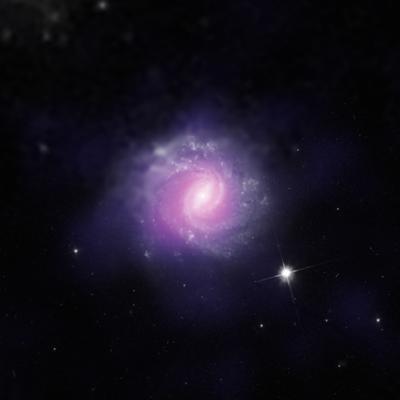.
Southampton researchers use high energy X-rays to peer beneath the obscuring skin of growing black holes

Astronomers at the University of Southampton are using X-ray vision to reveal supermassive black holes hidden beneath thick veils of interstellar gas in our cosmic neighbourhood.
Monster black holes sometimes lurk behind gas and dust, hiding from the gaze of most telescopes. But they give themselves away when material they feed on emits high-energy X-rays that NASA's NuSTAR (Nuclear Spectroscopic Telescope Array) mission can detect. That's how NuSTAR recently identified two gas-enshrouded supermassive black holes, located at the centres of nearby galaxies.
The findings of the work, led by Southampton-based PhD researcher Peter Boorman and Dr Poshak Gandhi, Associate Professor and STFC Ernest Rutherford Fellow in Southampton’s Astronomy Group, were presented during a press briefing at the 229th meeting of the American Astronomical Society in Grapevine, Texas, USA this month. Joining Peter Boorman at the press briefing was Ady Annuar, a graduate student at Durham University.
In a recent paper published in The Astrophysical Journal, Boorman (and colleagues from the NuSTAR active galaxies science team) described how data from NASA’s Nuclear Spectroscopic Telescope Array (NuSTAR) has been used to study the intrinsic behaviour of a ‘hidden’ supermassive black hole in a galaxy nearby to our own – IC 3639 - some 175 million light years from Earth, relatively close by in cosmic terms.
“Every large galaxy in the Universe is believed to host a supermassive black hole at their centre, millions of times the mass of our Sun,” says Boorman. “These systems can devour vast quantities of matter due to their extreme gravitational pull, making the black holes grow. The in-falling matter then emits radiation across the full electromagnetic spectrum. These growing supermassive black holes are called Active Galactic Nuclei (AGN).
“The emission can be absorbed by thick clouds of gas and dust covering the AGN,” Boorman continues. As the level of obscuration increases, only the highest energy X-rays can escape to be observed by us. X-rays are absorbed by the atmosphere so I use data from X-ray satellites located above our atmosphere – such as NuSTAR, Suzaku and Swift – to detect high energy X-ray emission throughout the Universe.”
“The black hole I’ve been studying is so hidden, that it requires highly sensitive observations in the highest energy X-rays to classify it as obscured. Such sensitivities are only available now with the NuSTAR satellite [launched in June 2012] which is designed to create images of the high energy X-ray sky sharper than ever before,” he adds. “By modelling the X-ray emission of supermassive black holes, we get a glimpse of their growth rates, and learn about the amount and composition of material blanketing them. IC 3639 turns out to be glowing extremely bright due to emission from hot Iron atoms whose origin is not fully understood.”
“In broader terms, we also hope to determine the distribution of obscured AGN across the Universe, and figure out how these supermassive black holes have evolved and grown over billions of years,” Boorman concludes. “For this purpose, we will soon begin a large new survey of other nearby AGN with NuSTAR, and we can expect many more discoveries in the coming years.”
Annuar's study of the spiral galaxy NGC 1448 discovered that X-ray emission from NGC 1448, as seen by NuSTAR and NASA’s Chandra X-Ray Observatory, suggests for the first time that, like IC 3639, there must be a thick layer of gas and dust hiding the active black hole in this galaxy from our line of sight.
Researchers also found that NGC 1448 has a large population of young (just 5 million year old) stars, suggesting that the galaxy produces new stars at the same time that its black hole feeds on gas and dust.
"These black holes are relatively close to the Milky Way, but they have remained hidden from us until now," said Annuar. "They're like monsters hiding under your bed."
Dr Gandhi believes that we are only now beginning to properly understand supermassive black hole growth in the obscured regime.
“Although X-ray astronomy was ‘born’ in the 1960’s, the field is still in its infancy in many respects,” he says. “NuSTAR is helping to change the picture of what we know about supermassive black holes, even in the local universe where many questions remain unanswered. It is really a privilege to be the first to peer into places in the universe where no one has been able to see before.”
Quelle: University of Southampton
